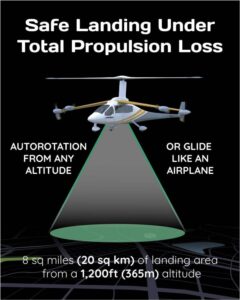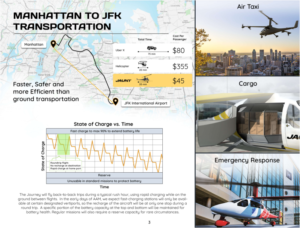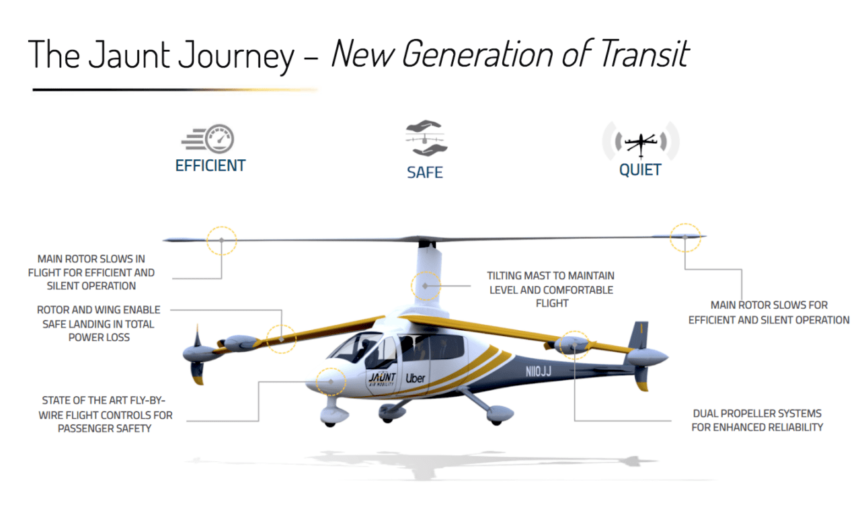The Jaunt Journey may be the most unique eVTOL (electric Vertical Take Off and Landing) machine coming to market, and it relies on something old and several things new for its advanced take on Advanced Air Mobility (AAM). What makes it special is its combining autogiro-like technology with electric power and some different approaches to the transitions between vertical and horizontal flight.
Jaunt promises to carry a pilot and four passengers 80 to 120 miles, pushing it into the realm of regional air mobility. It can top out at 175 miles per hour, or about the upper limits of most helicopters while pressing down with only 55 dBa of sound pressure, considerably below that of any helicopter. Its performance and several distinguishing features make it all the more unique.
Somewhat Like an Autogiro
Autogiros were pre-helicopter rotary-wing aircraft that could lift off and alight quickly because of a large, usually un-driven, series of blades above the fuselage. Note how easily this autogiro lands on a golf course. Note also that the machine has small wings to lighten the load on the blades.
Kellett K-3 Autogiro landing — excerpt from the movie “It Happened One Night” (1934) Also, notice the production error when the character King Westley, the pilot, exits from the K-3 Autogiro, you do not see the real pilot, but when they cut to another angle, you can see the real pilot hunching forward, hiding from the original camera. (YouTube.com)
More Like a Gyrodyne
On a much bigger scale Britain’s Fairey Aircraft built the Rotodyne, powered by two turboprop engines on the wings and tip jets on the rotor, fed with jet fuel and bleed air from the turbine engines. Unfortunately, it was noisy – enough so to be rejected by potential customers. This video from ElectricAviation.com shows the Rotodyne and other similar craft that preceded the current electric Jaunt Journey. Much has been learned since the cancellation of the Rotodyne project in 1962.
This type of craft is a gyrodyne, a composite of gyrocopter, helicopter, and conventional aircraft. The technologies and the clever design of the Jaunt overcome several factors that have prevented development of this configuration until now.
Outwardly similar (but much sleeker) to the Kellet and other autogyros of the 1930s, the Jaunt Journey differs in having a powered rotor and high-aspect-ratio wings with two electric motors on each outer section. These “are sized for 175 mph cruise flight,” and can provide yaw control.
Propellers are smaller diameter to keep tip speeds down and noise to a low level.
The rotor atop the mast hides some significant engineering approaches. Where a conventional autogiro’s rotor spins about in response to the wind flowing up from under it, Jaunt’s powered rotor slows to maintain a blade speed that matches the speed of the aircraft. This Reduced Rotor Operating Speed Aircraft, or ROSA, reduces drag and noise while making the Jaunt more efficient. As Jaunt explains, “The Slowed Rotor technology creates the most efficient vertical take-off and landing aircraft with airplane performance.”
Helicopters have operating limits based on a factor called the advance ratio (μ) equal to the blade tip speed divided by the aircraft speed. An advancing blade is moving at it rotational speed plus the forward speed of the aircraft, sometimes nearing significant Mach numbers. A retreating blade can be near its stall speed. This creates a potentially destructive stress, reduced by slowing the blades and using the wing to provide needed lift.
A helicopter needs to alter the angle of attack of the advancing and retreating rotor blades. As seen near the end of the video, standard helicopter practice requires an assemblage of small parts needing to work in a coordinated way. Jaunt reduces this complexity to a simple, but carefully specified, “elastomeric” material that requires far less maintenance.
The rotor tops a mast that can be tilted to always be over the center of gravity of the Journey, no matter how the load is distributed. This LevelFly™ technology eliminates the need to tilt the fuselage and enables a more comfortable ride.
With a triple-redundant Fly by Wire (FBW) system and conventional controls, the Journey also has double and triple redundancy in power and other systems essential to flight. All going awry is unlikely with a single-side motor failure, for example – being a 1X108 chance, or a possible occurrence in one hundred million flight hours. A failure of both sides raises that to 1X109, or one in a billion flight hours. Even then, the craft can be flown as a helicopter.
Autorotation and winged flight allow a glide ratio of 10 to 12 to one. That enables selecting a landing spot within an eight square mile area from an altitude of 1,500 feet, eliminates the need for a ballistic parachute and allows a controlled descent. Most multi-rotor competitors have a glide ratio of zero, and having a two or three ton vehicle coming down by parachute would still be a crushing experience for those below.
Either taking off or descending, the rotor or the wing can provide an independent means of ensuring flight. There are no points at which the Journey is not controllable.
Not a New Thing
Jaunt’s Journey is not an untried approach. It’s a development of the Carter Copter, which first flew in 1998 and the rights to which Jaunt acquired in 2019. Jaunt was co-founded by Martin Peryea, a senior rotorcraft engineer with Bell Helicopters. Peryea became CEO of Jaunt in 2020.
Cartercopter and Jaunt have made hundreds of flights and accumulated significant hours of testing and development. The design seems to inspire confidence, with Loz Blaine writing in NewAtlas.com in 2020, that despite its “weird” hybrid looks, “It’s the safest of all the eVTOL designs we’ve ever seen, and it has another killer advantage in that it requires no special certification.” Indeed, Jaunt is certifying the Journey under Canada’s part 29 rules, which seem to allow for “weird” configurations.
Jump Starts and Regeneration
A decade ago, Tine Tomazic of Pipistrel described how the Alpha Electro would use a wind-milling propeller during landing to regenerate up to 13 percent of energy from each landing on every approach, “increasing endurance.” Its 1,800 millimeter (71 inch) propeller allows only that relatively small percentage of energy recovery.
Jaunt, however, has a 15.24-meter (50 feet) diameter rotor with weighted tips. The momentum these provide enables will work not only at a high level of regeneration, but will enable takeoffs and climbs to 1,500 feet with no power drained from the Journey’s batteries.
This seeming unfeasibility is possible because Jaunt’s landing zones will be equipped with flywheel generators or other high power electrical supplies to spin up the craft’s rotor. Climbs are thus possible with little loss of stored energy. The combination of high-inertia rotor blades and ground-supplied takeoff power will save the batteries for longer cruising distances.

Conversely, descents with the large rotor diameter and weighted tips will recharge the flywheel on the ground from the energy generated by autorotation – a high percentage of the total energy created from the descent. Although not a perpetual motion machine, Journey is a highly-efficient energy recovery machine.
13 years ago, your editor interviewed Dr. Andrew Frank of the University of California at Davis. He discussed the idea of connecting electric cars and buses to the grid to act as mobile “peaker plants,” offsetting the load on municipal resources. Jaunt would seem to address that possibility, providing V-to-G (Vehicle-to-Grid) power during high demand or emergency conditions.
This added benefit of electric aviation could make Dr. Frank’s vision a reality.
Simplicity and Manufacturability
With electric power and controls created in association with BAE Systems, reliable flight is a given. Patented thermoplastic moldings will provide smooth, aerodynamic surfaces with unbroken contours.
476 Orders
As of February, Jaunt had 476 orders worth $1.14 billion from seven customers in six countries. The company foresees 1,500 orders by 2025 and as many as 15,000 to 28,000 by 2035.
Perhaps operating costs may be a big draw. Jaunt calculates a Bell 505 helicopter at $1,100 per flight hour, including the cost of $5.00 per gallon avgas, while a Jaunt Journey will cost $606 per flight hour, including battery replacement – a drop of 44 percent compared to the Bell. Over the long term, per-mile passenger costs could drop from $4.00 to $5.00 per hour to $1.00 to $2.00 per hour considering increased load factors and utilization.

Surprisingly, costs for a Jaunt journey compare more than favorably with even an Uber ride. A trip from Manhattan to JFK Airport, for instance, in a ground Uber takes 75 minutes and costs $80 per passenger. It also takes two bridge crossings and a circuitous 19-mile route. Jaunt can fly a straight line in 20 minutes and cost only $45 per passenger. It makes even greater economic sense than the same flight by conventional helicopter, which runs $355 per passenger.
Currently, Jaunt is building early versions of the Journey, with wings, tail boom, and empennage nearing completion. They are being built from aluminum at this point, but this will be replaced with engineered thermoplastics in future iterations.
This combination of performance, operating costs, and safety speak well for the Jaunt Journey. With test flights coming in 2025 and certification within two years, Jaunt may well be a formidable competitor in the near future.

